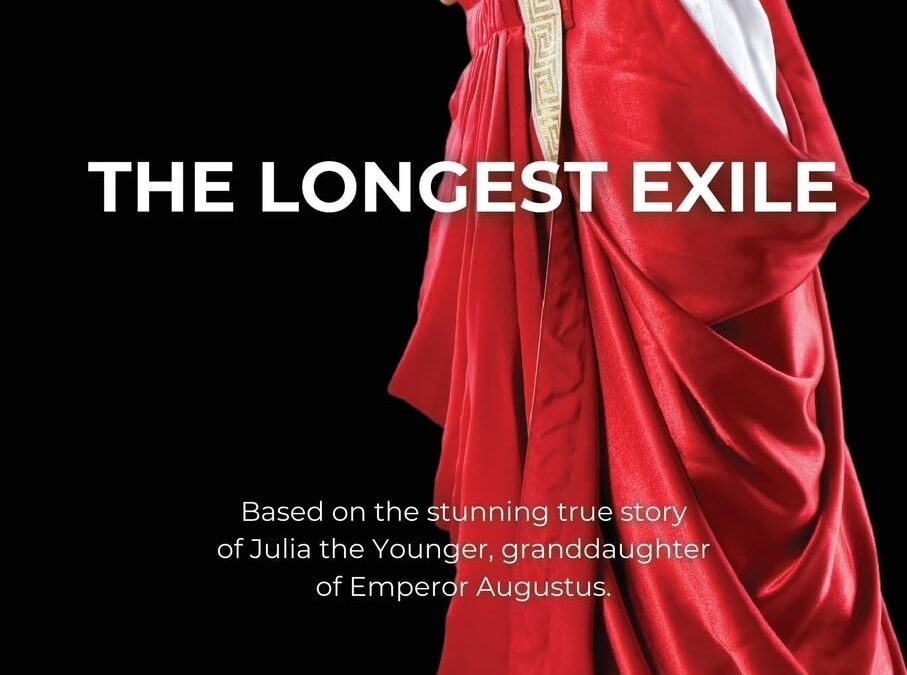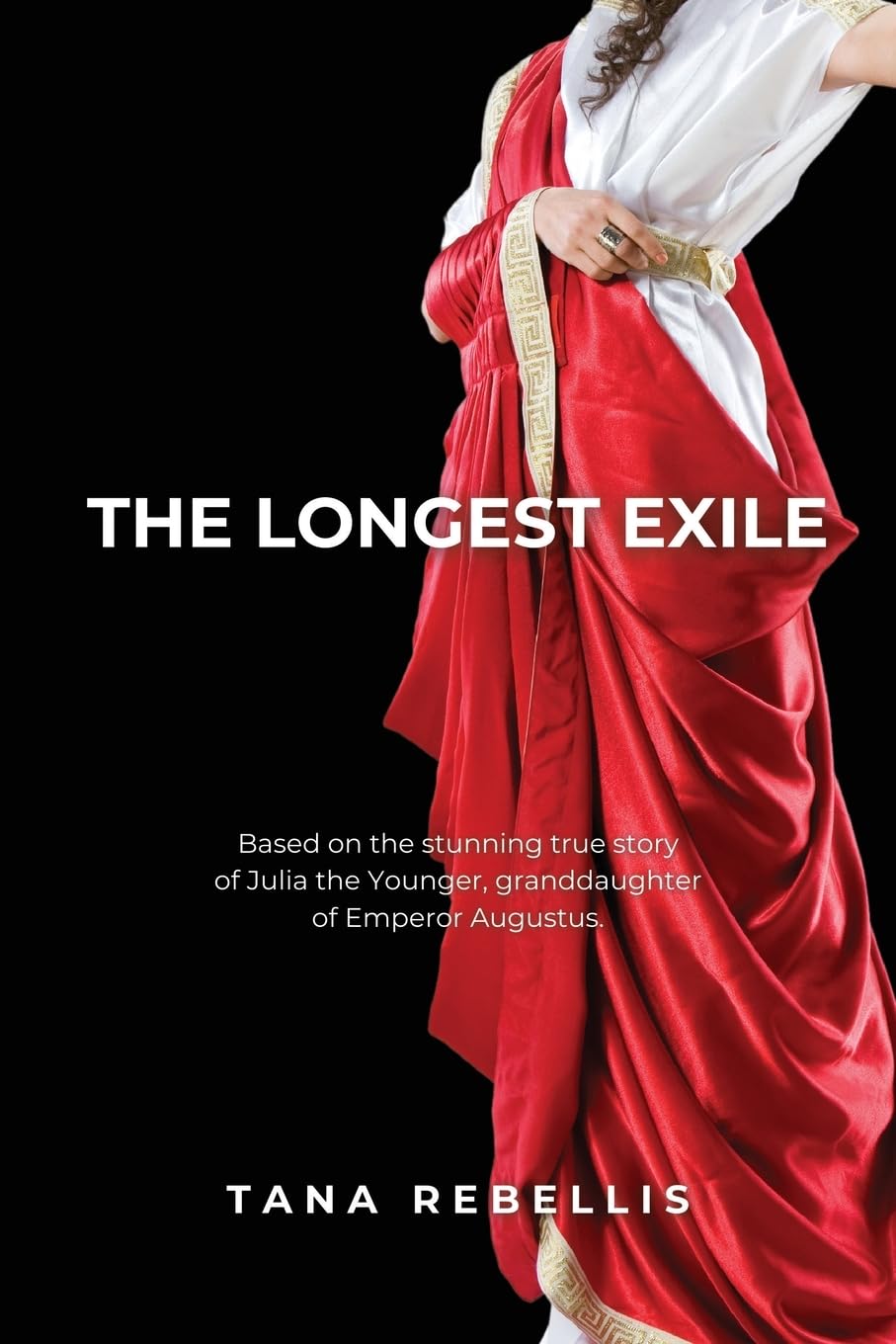Historical Fiction
The Longest Exile
Set in Rome, 8 CE. Julia, the eldest granddaughter of Augustus, finds herself in a dire predicament: she is four months pregnant, but her husband was executed a year ago for treason. The math is simple and damning. Julia is exiled to a remote island as punishment for her indiscretion, upending her privileged life.
About the Author
Tana Rebellis is a pen name of Kasey Morris, who also writes romantic comedies (www.kaseymorris.com). She studied Classics at Princeton University, then Classical Archaeology at Oxford. When not reading, writing, or working, she and her husband spend time with their animals on their farm in Virginia.
*Taken from TanaRebellis.com
Ancient Roman history always takes me back to my Jr. High School days, reminiscing about lessons on the ancient world, Caesar, the Spartans, and all the classics that come to mind when we think of “Rome.” However, one aspect I hadn’t considered much until now is the concept of exile in Rome. This changed when I picked up Tana Rebellis’s novel, The Longest Exile. This historical fiction work not only captivates with its rich narrative but also offers invaluable lessons for aspiring writers who seek to learn through their reading. So, let’s dive into this compelling novel and explore some key “Writing Lessons” that authors can glean from Rebellis’s work.
According to TanaRebellis.com, “The Longest Exile stems from her research on the phenomenon of Julio-Claudian island exile, a project for which she won the Princeton University Department of Classics John J. Keaney Prize for Best Senior Thesis.” This assurance of historical authenticity enriches the narrative, blending real Roman culture and history seamlessly into the storyline. I had the privilege of receiving an early reader copy of her novel through NetGalley, and it was officially published on June 18, 2024.
Book Summary
The Longest Exile is set in Rome, 8 CE. Julia, the eldest granddaughter of Augustus, finds herself in a dire predicament: she is four months pregnant, but her husband was executed a year ago for treason. The math is simple and damning. Julia is exiled to a remote island as punishment for her indiscretion, upending her privileged life. As she struggles to adjust to her new circumstances, a suspicious accident kills her only confidante, and she finds that trust is increasingly hard to come by—especially in a world where power is everything and where people will do anything to get it.
Soon, Julia is forced not only to question what else fate has in store but to fight for her illegitimate baby’s survival. Julia’s scheming mother and slightly insane younger brother are already political exiles, but their newest plots pull her further into a deadly web of family betrayal and treason that threatens to taint Rome for generations to come. Further complicating matters is Titus, the bastard son of a senator. As one of the guards tasked with ensuring that Julia never escapes her island prison, she should resent him—but instead, she finds herself increasingly drawn to him, at great risk to both their lives.
Book Review
Overall Impressions: Tana Rebellis’s novel, The Longest Exile, presents an engaging premise set against the backdrop of ancient Rome. The rich historical setting and complex character dynamics pull readers into a world of political intrigue and personal struggle. The narrative’s strength lies in its ability to weave historical accuracy with compelling storytelling, while also portraying a new perspective on an event that wasn’t commonly known about for that time period.
Strengths:
- Engaging Premise and Historical Depth: The story’s foundation on historical events and settings provides a rich, immersive experience. Rebellis’s extensive research is evident, and she skillfully incorporates historical details that bring the ancient world to life. Whether you are an expert on Ancient Rome or a newbie to the era, any reader can grasp the rich Roman culture and history with the storyline.
- Character Development: The characters, particularly Julia those in her exiled realm, are well-developed and believable. Rebellis excels in portraying their motivations, struggles, and growth throughout the novel while also staying true to their personalities and roles in the novel as well as in the time period.
- Narrative Engagement: The initial premise and the unfolding drama keep readers hooked. The interplay between historical events and personable characters adds depth to the narrative.
Weaknesses:
- Over-explanation: At times, Rebellis does not trust the reader to make connections, leading to over-explanation. At times, this disrupted the narrative flow and took readers out of the story. It felt like Rebellis would justify her reasoning for certain foods, props, or events that took place in particular scenes. So, she would overexplain or use too many appositive phrases to try to get the reader to believe that this was plausible. Reading the story, you know it is well-researched and none of the things that the author seemed to try and justify for being in the novel felt like they needed to be. I say this as someone who is not an expert of Ancient Rome, meaning that I wouldn’t have commonly known the cuisine or practices of the time, but I can tell by the easy integration and authenticity of the story that it belongs. By seemingly “justifying” the reason for it being there with phrases like “as was common for my role as granddaughter of Augustus” or “commonly eaten at my station” and phrases like theses, it took me out of the storyline instead of allowing me to stay in the narrative.
- Inconsistent Pacing: The pacing of the novel is uneven. While the beginning is captivating, the middle sections slow down significantly, making the storyline drag. The final quarter picks up again but leaves the ending feeling somewhat incomplete due to its setup for a sequel. While I do not know everything that needs to be included in the follow-up novel, it did feel like the author dragged certain scenes in the middle but rushed the ending to give an almost conclusive end to the novel but then left out chunks so there could be a sequel.
- Ending: The ending, designed to lead into a series, feels abrupt and unfinished. While it sets the stage for future books, it may leave readers wanting more closure. The reason it felt like this is because there was a sort of summary to explain some of the happenings after the storyline finished but still didn’t give a complete perspective as to why it ended where it did. Certain characters storylines were concluded in the summarized events even though they seem to be a major part of the parts that were not included in the ending.
Conclusion:
Overall Rating: 4 out of 5 Stars
The Longest Exile is a promising novel that, despite its flaws, offers a compelling read for historical fiction enthusiasts. It’s a testament to Rebellis’s potential as a historical fiction author and provides valuable insights for writers looking to improve their craft.
Writing Lessons for Authors
- Engaging Premise and Setting:
- Rebellis demonstrates the importance of a strong premise. The historical setting of ancient Rome, combined with personal drama, creates an engaging backdrop for the story. Writers can learn from this by ensuring their settings are not just backdrops but integral to the narrative.
- Balancing Exposition and Narrative:
- One of the critical takeaways is the balance between exposition and narrative. Rebellis’s tendency to over-explain historical details, while informative, can interrupt the story’s flow. Writers should aim to integrate background information seamlessly into the narrative, trusting readers to understand without over-explanation — as well as trusting the reader to trust your research because it is seamlessly integrated into the foundation of the story.
- Character Development and Consistency:
- Rebellis’s characters are well-drawn and consistent. Julia’s evolution throughout the novel is believable and engaging. Writers can learn from this by focusing on creating multi-dimensional characters whose actions and growth are consistent with their development.
- Pacing in Storytelling:
- The pacing issues in The Longest Exile highlight the importance of maintaining a steady narrative pace. Writers should be mindful of how the story’s rhythm affects reader engagement. Avoiding unnecessary filler scenes and ensuring each part of the story advances the plot can help maintain momentum.
- Handling Endings in Series:
- Writing a satisfying ending for a series installment is crucial. While setting up for a sequel, it’s important to provide a sense of closure while still staying true to the timeline you are portraying. Rebellis’s ending, while intriguing, felt somewhat incomplete. Writers should strive to give readers a fulfilling experience with each book, even when planning a series. You don’t want your readers to get to the end of the book and feel like large portions of the book were almost unnecessary before introducing a second book to the series.
Conclusion
The Longest Exile by Tana Rebellis is a valuable addition to the historical fiction genre, offering rich historical detail and compelling character arcs. For writers, it provides a wealth of lessons on crafting engaging premises, balancing exposition with narrative, and developing consistent characters. Despite some pacing issues and an incomplete ending, the novel’s strengths make it a worthwhile read. If you’re looking to immerse yourself in ancient Rome and learn from Rebellis’s approach to storytelling, The Longest Exile is a book to consider.
Final Recommendation:
I recommend The Longest Exile for historical fiction fans and writers looking to enhance their craft through reading. It’s an engaging story with a lot to offer both as a narrative and as a learning tool.

Amber Parr Burdett
Author. Editor. Coach. Mother.
Amber is a passionate writer, editor, and writing coach. Her mission is to empower individuals, like you, to discover their stories and boldly embrace a purpose-driven writing journey.
Copyright © 2024 A. R. Parr Burdett


